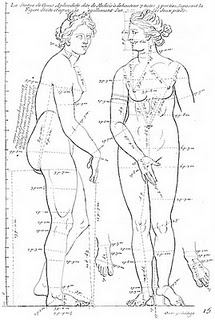|
|

Figure Drawing EbooksGerard Audran'sThe Proportions of the Human BodyWith 30 Platesby Gerard Audran |
�
Home Learn How to Draw
Learn How to Draw How to draw People
How to draw People
 Stumble It!
Stumble It!
Learn How to Draw Perspective How to Paint
How to Paint How to Draw Cartoons
How to Draw Cartoons
�
Learn How to Draw Perspective
�
|
Gerard Audran
|
At Amazon.com
Les Proportions du Corps Humain, Mesurees sur les plus belles Figures de l'Antiquite an original copy.
an original copy.
Preview the book at Google Books.



Les Proportions du Corps Human, Mesurees sur les plus belles Figures de l'Antiquite By Gerard Audran.
At Amazon.com:
Les Proportions du Corps Humain, Mesurees sur les plus belles Figures de l'Antiquite
"Gerard Audran, the most skilful draughtsman of the French school, and evidently a master of drawing, engraved the best work of Nicolas Poussin, which may perhaps also be considered a wonder of engraving. " Time disclosing Truth " is a magnificent composition in which the painter put forth all his powers to prove the injustice of his contemporaries towards him, and it found an admirable interpreter in Gerard Audran. " Using by turns the needle and the graving-tool, he seems," says M. Denon, " to have employed these two instruments to supplement each other like the different tints under a painter's brush." The work is in fact so beautifully blended together, that in looking at it we see the composition only, and forget until we examine it closely that the engraver's skill must almost have equalled that of the painter, for him to have rendered so faithfully the work he had undertaken. Although Gerard Audran only occasionally placed his talent at the service of Nicolas Poussin,- and produced very few engravings after that master, he must still be classed with Jean Pesne, and a female artist, of whom we shall presently speak, amongst the chief of the engravers who took their inspiration from Poussin's works."
"His father, Claude Audran, was but an inferior engraver, but fortunately he knew enough to guide a beginner. It was under his direction that Gerard produced his first engravings which showed no decided taste, and gave no hint of the future works which were to come from the master's hand. A visit to Italy in early life settled his taste and expanded his mind. When he went to Rome he already knew enough of drawing to appreciate the works he saw there, and he had acquired sufficient skill in using the graver to be able at once to set to work profitably. Although he had gained admission to the studio of Carlo Maratti, he chiefly copied antique statues and the works of great masters, and we can imagine that this style of working improved him more than the lessons of his teacher." - Google Books result.
Related post on the blog: Les proportions du corps humain, measurées sur les plus belles figures de l'antiquité |


